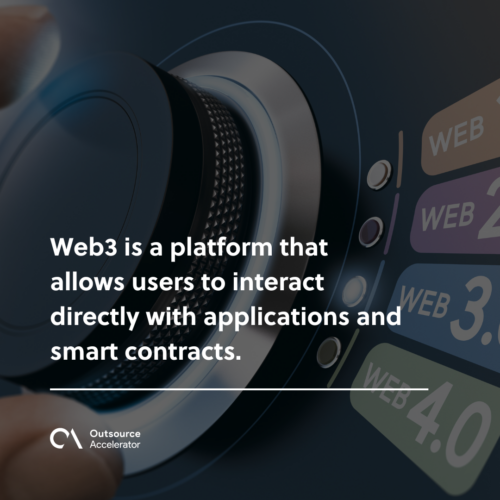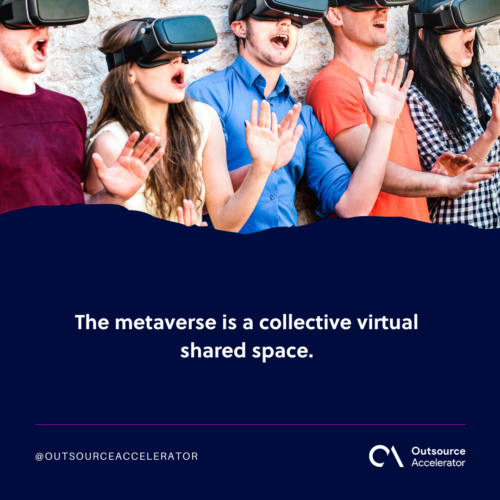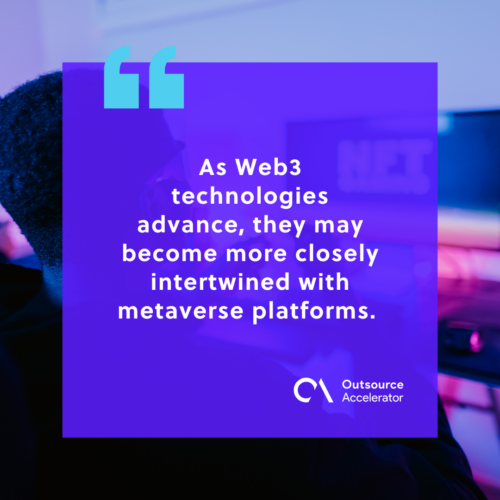Web3 vs. Metaverse: Exploring key differences and similarities

There’s a growing curiosity and excitement about the future of the internet and the immersive virtual experience it holds.
In less than two decades, people have made huge leaps in the capabilities of the internet, going from simple page browsing to making it an essential part of daily life.
It seems that going online will continue to be an unavoidable part of our lives going forward, mostly for good. However, there are developing technologies seeking to take us even further.
Web3 and the metaverse are at the forefront of this new digital revolution in the online landscape.
In this article, we’ll explore web3 vs. metaverse, uncover their unique characteristics, and discuss their potential implications for industries.
What is Web3?
Web3 is a platform that allows users to interact directly with applications and smart contracts. In contrast to the current internet, Web3 doesn’t rely on central servers and enables direct interaction between peers.
Web3 has been described as a possible new iteration of the World Wide Web.
To give context to this naming scheme, Web1 refers to the internet from roughly 1990 to 2004. The internet during this time mainly consisted of static web pages that users would casually read through.
Web2 describes the current state of the internet. Interaction is a large part of its usability, and the platform can change based on a user’s preferences. Social media sites are a good snapshot of the current capability of the Internet.
Web3 is frequently referred to as the “decentralized web.” It was designed as an open standard for decentralized application development. The platform refers to any decentralized application that runs on a blockchain network and uses its own currency for transactions.
Web3 uses a range of technologies, including peer-to-peer networks, end-to-end encryption, and smart contracts.

Components and characteristics of Web3
Web3 consists of the following components and characteristics:
Blockchain and cryptocurrency network
The blockchain is the underlying technology that makes cryptocurrency possible. The blockchain records every single transaction in chronological order to create an unchangeable history of all transactions made on the network.
Cryptocurrency is a digital currency with the defining feature of not being issued by any central authority, making it theoretically immune to government manipulation.
Artificial intelligence
Artificial intelligence (AI) is the branch of computer science that aims to create machines capable of performing tasks that normally require human intelligence.
AI’s growing visual perception, speech recognition, and decision-making abilities will prove pivotal for Web3.
Augmented reality and virtual reality
Augmented reality (AR) and virtual reality (VR) use computer-generated images to create illusions of real environments. These technologies will enable decentralized applications that can meaningfully interact with real-world objects.
Semantic web
The current semantic web refers to an extension of the World Wide Web, developed to make data more meaningful, useful, and accessible. The semantic web provides a common framework for data representation and knowledge sharing.
3D graphics and spatial web
3D graphics will create virtual environments in Web3, along with AR and VR. Similarly, the spatial web transforms web pages into objects with depth that can be interacted with in multiple dimensions.
Ubiquitous connectivity
Ubiquitous connectivity refers to having online access from anywhere and everywhere. Web3 benefits from this as it enables real-time interactions between users, devices, and services.
What is the metaverse?
The metaverse is a collective virtual shared space. It’s created by the convergence of virtually-enhanced physical reality and physically persistent virtual space.
Metaverse has been described as the total of all virtual worlds, augmented reality, and the internet.
Applications of the metaverse
While still relatively new, a few potential applications have already been poised for the metaverse, including:
Virtual reality
Virtual reality is key to the metaverse, as it’s the technology that makes it possible to simulate experiences that aren’t possible in the real world.
Within the metaverse, users can interact with each other and objects in a manner similar to physical reality.
Education
The education industry is being seen as a prime location for the metaverse platform. Online classes are already being held in lieu of physical classes. The virtual classrooms created by the metaverse can let users learn new topics, collaborate, and get direct feedback.
Gaming
Game developers can create immersive virtual environments for players. These virtual environments enable players to explore and interact with each other.
Social networking
Going a step beyond our current social media landscape, the metaverse can allow friends to connect from across different realities. This also has applications for business collaboration.
Healthcare
Doctors can use metaverse technology to interact with patients remotely using avatars. In some cases, they may no longer be required to travel for face-to-face treatment or consultation.
Entertainment and media
So much of the entertainment industry can be translated into the metaverse reality. Users can watch movies, attend concerts, visit themed worlds, participate in live performances, and view advertisements all on the virtual stage.

Web3 vs. Metaverse: Similarities
Here are the key similarities between Web3 and the metaverse:
- Both are decentralized systems. Web3 is built on a peer-to-peer network of computers and leverages blockchain technology to provide a decentralized web. The metaverse is a virtual world that operates on a decentralized blockchain network.
- Both allow users to own and control their digital assets. Web3 prioritizes cryptocurrencies and other digital assets. The metaverse allows users to own virtual real estate and digital assets like NFTs (non-fungible tokens) that can be traded and used within the platform.
- Both are designed to be compatible with similar platforms. Web3 can exchange information with other blockchain platforms. The metaverse can share virtual experiences across other networks.
- Both provide immersive experiences. This is clear with the visible usage of virtual reality in both technologies.
- Both are community-driven systems. Web3’s very nature relies on the active participation of developers, users, and other stakeholders to build and maintain the decentralized web. The metaverse depends on its community to create virtual worlds, govern the platform, and decide its future.
Web3 vs. Metaverse: Differences
Here are the key differences between Web3 and the metaverse:
- They currently have different objectives. While the outlook is that their similarities will grow over time, currently, Web3 is more focused on providing a more democratic version of the current Internet. The metaverse simply wants to give users access to virtual reality.
- They differ in current applications. Web3 is primarily the engine that makes use of blockchain’s improvements. The metaverse has a much wider application use in healthcare, games, education, and entertainment.
- They consist of different fundamental technologies. Web3 uses the blockchain and is run by a decentralized peer-to-peer network. Connectivity, interfaces, decentralization, a creator economy, and advanced technology run the metaverse ecosystem.
- They have different views on ownership. Web3 aims to keep tech giants from having a monopoly on the internet. The metaverse, despite its decentralized foundation, is open to selling virtual properties to large corporations.
The future of Web3 and metaverse
Both Web3 and the metaverse hold tremendous potential for transforming our digital experiences and interactions. As these technologies continue to evolve and mature, they’re expected to have a significant impact on various aspects of our lives.
Here are some potential directions and developments for both technologies in the future:
Interconnectivity and integration
One possible future is the seamless integration of Web3 and the metaverse. As Web3 technologies advance, they may become more closely intertwined with metaverse platforms.
This integration would allow users to access decentralized applications and blockchain functionalities within virtual worlds. It could enhance the overall customer experience and open up new possibilities for decentralized finance and digital ownership.

Enhanced immersive experience
The future of the metaverse is likely to focus on creating even more immersive and realistic experiences for users. Advancements in virtual reality, augmented reality, and mixed reality will play a vital role in this evolution.
Users can expect to engage in lifelike situations, explore highly detailed virtual environments, and interact with realistic avatars. The boundaries between the physical and virtual realms will begin to blur for the better.
Social and collaborative spaces
The metaverse is expected to become a hub for social interaction and collaboration. Virtual worlds will offer spaces for people to connect, communicate, and engage in shared experiences, whether for work, entertainment, or socializing.
The metaverse can host virtual meetings, conferences, concerts, and other events. This would transcend geographical limitations and provide new global collaboration and community-building avenues.
Decentralized governance and ownership
Web3’s underlying principles of decentralization and transparency will likely continue to shape the future of digital governance and ownership.
With the help of blockchain technology, individuals may have increased control over their data, digital assets, and identities.
Smart contracts and decentralized autonomous organizations (DAOs) may empower communities to make collective decisions and democratically govern virtual spaces.
Economic opportunities and new business models
The metaverse is expected to create new economic opportunities and disrupt traditional business models. As virtual economies flourish, individuals can monetize their creativity, skills, and assets within virtual worlds.
Digital currencies, non-fungible tokens (NFTs), and virtual marketplaces may become integral parts of these economies. Web3 will also do its part in enabling new forms of entrepreneurship, digital asset trading, and value exchange.
Ethical and regulatory considerations
As Web3 and the metaverse gain prominence, there will be a growing need for ethical frameworks and regulations. These would address privacy, security, digital rights, and content moderation concerns.
Leaders will need to consider some key things to shape the future of these technologies. These include ensuring inclusivity, preventing abuse, and balancing individual freedom and responsible governance.
Due to the rapidly evolving nature of technology, it’s difficult to predict the exact future of Web3 and the metaverse.
However, it’s clear that both of these technologies have the potential to revolutionize the way we interact with digital content. They redefine the concept of ownership and create new digital ecosystems that go beyond our understanding of the online world.







 Independent
Independent




